People's Liberation Armed Forces of South Vietnam
The People's Liberation Armed Forces of South Vietnam (PLAF), or Viet Cong's army was the official army of National Liberation Front of South Vietnam. The PLAF forces were independent forces to People's Army of Vietnam. The PLAF was unofficially established after 1954 and was recognized as main battle forces in South Vietnam by North Vietnam in 1961. The PLAF forces was legistimately independent on People's Army of Vietnam but politically because more than a half of troops in The PLAF forces were members of Labor Party of Vietnam, the old name of Communist Party of Vietnam.
Organisation
According to 1954 Geneva agreements, the Viet Cong was not compulsorily removed to the North because it was a political entity, not a military force. The NorthVietnamese support for the Viet Cong to establish the NLF forces was on the basis that it remained a militia in the South. The PLAF was recognized as the official force on February 15, 1961 by North Vietnam. The PLAF had missions of protecting South Vietnamese against attacks of Republic of Vietnam and the US.[1] Most early soldiers in the PLAF were South Vietnamese. However, casualties of war forced North Vietnam to provide volunteers for the PLAF. As the result, many people mistakenly believe that the PLAF was a part of the People's Army of Vietnam. Democratic Republic of Vietnam and other communist nations recognised the PLAF as the main militarily force in South Vietnam and considered the People's Army of Vietnam as supporter.[2] After the reunification of Vietnam, the PLAF was merged into the People's Army of Vietnam.
Developments
January, 1961, the militia in South Vietnam became the official forces. On February 15, 1961, North Vietnam recognized it as the main battle force in South Vietnam. At the end of 1961, there were 24,500 soldiers and 100,000 militants in the PLAF. The PLAF had 11 battalions. Generals were Trần Văn Trà, Hoàng Văn Thái, Lê Trọng Tấn, Lê Đức Anh, Nguyễn Thị Định...
The PLAF only acted in rural areas due to hostile activities of Ngô Đình Diệm's regime. However, the number of soldiers still went up to 64,000 in 1963. As the result, regiments were established. Since 1964, North Vietnam started providing soldiers for the PLAF by voluntary mans. The number of the PLAF soldiers reached over 200,000 in December 1974, including 90,000 from the North.[3]
The balance between the PLAF and coalition of US army and ARVN
- "1959 – 1960, coalition 7, the PLAF 1 (the US had not taken part in);
- 1960: coalition 10, the PLAF 1;
- 1961: coalition 7, the PLAF 1;
- 1962 – 1963: coalition 5, the PLAF 1;
- 1965 - 1968: coalition 3, the PLAF (including People's Army of Vietnam soliders joined PLAF) 1. (The US and People's Army of Vietnam started their intervention).
The PLAF also had forces of urban special forces, especially in Saigon. These forces had mission of carrying out non-appropriate attacks against the puppet regime of Saigon and American forces and its allies in urban areas, especially in Saigon. The urban special force of Saigon is famous in the 1968 Tet offensive.
The PLAF merged into the People's Army of Vietnam after the reunification of Vietnam by the 1976 general election.[4]
Equipments
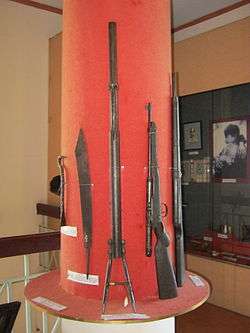
Viet Cong established the NLF army in order to create the status of independence with North Vietnam and People's Army of Vietnam. Forces of PAVN, that went to the South, had the only missions of support for the NLF army. The NLF army had different uniforms, flags and badges to those of the PAVN.
.jpg)
Artillery
- ZPU-4 quad 14.5 mm anti-aircraft machine gun
- ZU-23 twin 23 mm anti-aircraft cannon
- M1939 37 mm anti-aircraft gun
- S-60 57 mm anti-aircraft gun
- 85 mm air defense gun M1939 (52-K)
- 100 mm air defense gun KS-19
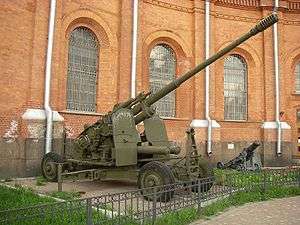
- 82 mm, 107 mm, 120 mm, and 160mm mortars
- 122 mm Katyusha rockets
- Type 63 multiple rocket launcher
- BM-21 Grad
- BM-25 (MRL) limited numbers
- 122 mm gun M1931/37 (A-19)
- 122 mm howitzer M1938 (M-30)
- D-74 122 mm Field Gun
- 130 mm towed field gun M1954 (M-46)
- 152 mm howitzer M1943 (D-1)
- 152 mm towed gun-howitzer M1955 (D-20)
Aircraft weapons
Small arms

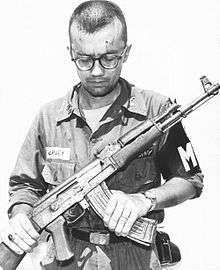
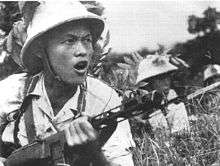
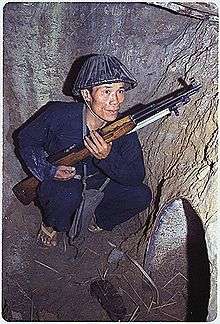
Handguns
- Tokarev TT-33 – Soviet-designed single-action 7.62×25mm semi-automatic pistol. More commonly used were the Chinese variants of the T33, known as the Type-51 and Type-54. Carried by NVA and Viet-Cong officers, it accepted an 8 round single stack box magazine.[5]
- Makarov PM – Soviet-designed double/single-action 9×18mm Makarov (9.5×18mm) semi-automatic pistol. Reproduced in China as the Type-59, this small and reliable pistol became the standard sidearm of communist forces in Europe and Asia. Utilizing a simple blow-back action, this self-loading pistol fed from an 8 round single stack box magazine.[5]
- P-64 CZAK handgun
- Nagant M1895 revolver
- Type 14 8 mm Nambu Pistol Pistol (Captured from the Japanese) Used By North Vietnamese officers
- Stechkin automatic pistol is a Russian selective fire machine pistol.
- Walther P38 German pistol captured during World War II by the Soviet Army; supplied to the Viet Cong in very limited amounts
Automatic and Semi-Automatic Rifles
- AK-47 and AKM assault rifles (from the Soviet Union and Warsaw Pact countries)
- Type 56 assault rifle (from the People's Republic of China)
- Vz. 58 assault rifle (from the Czechoslovakia)
- Type 63 assault rifle
- Sturmgewehr 44 assault rifle (captured by the Soviets during World War II and provided to the VPA and the PLAF as military aid)
- SVD-63 semi-automatic marksman rifle, also known as the "Dragunov" sniper rifle
- MAS-49 rifle Captured French rifle from first Indochina War, used by NVA throughout the 1950s and up to the mid 1960s
- SVT-40 Soviet rifle used in limited numbers, used in early stages of the war.
- SKS semi-automatic carbine, also known as Simonov
Bolt-Action Rifles
- MAS-36 rifle Captured French rifle from first Indochina War, used by NVA in earlier stages of the Vietnam War
- Mosin–Nagant bolt-action rifles and carbines (from the Soviet Union, Warsaw Pact countries, and the People's Republic of China)
- Mauser Kar98k bolt-action rifle (many of the Mausers used by the VPA and the PLAF were from rifles captured from the French during the First Indochina War and rifles provided to them by the Soviets as military aid)
- Type 99 Rifle captured from the Japanese during World War II
Submachine Guns
- K-50M submachine gun (Vietnamese edition, based on Chinese version of Russian PPSh-41, under licence)
- Škorpion vz. 61 sumbmachine gun from Czechoslovakia
- PPSh-41 submachine gun (both Soviet and Chinese versions)
- MP-40 German sub machine captured during World War II by the Soviet Army, supplied to the Viet Cong in limited amounts
- MAT-49 submachine gun – So many were captured from the French by the North Vietnamese that many were converted to 7.62×25mm.[6]
- PM-63 Polish submachine gun
- MP-38 submachine gun (captured by the Soviets during World War II and provided to the VPA and the NLF as military aid)
- PPS-43 Russian submachine gun
Machine Guns
- Type 99 LMG
- RPD light machine gun
- Degtyarev DP light machine gun
- SG-43/SGM medium machine guns (including Communist Chinese copies of these guns)
- RPK light machine gun
- PK machine gun
- MG-34 light machine gun (captured by the Soviets during World War II and provided to the VPA and the NLF as military aid)
- MG-42 medium machine gun (captured by the Soviets during World War II and provided to the VPA and the NLF as military aid)
- Uk vz. 59 general-purpose machine gun
- DShK heavy machine gun
- PM M1910 heavy machine gun
Grenades and other explosives
- F1 grenade
- Type 67 ChiCom Stick Grenade
- RG-42 grenade
- RGD-5 grenade
- 9K32 Strela-2 anti-aircraft weapon
- RPG-2 anti-tank weapon (both Soviet and locally produced B-40 and B-50 variants used)
- RPG-7 anti-tank weapon
- Type 69 RPG anti-tank weapon
Flamethrowers
- LPO-50 Flamethrower (limited use)
Vehicles
- PT-76 amphibious tank
- Type 62 light tank
- Type 63 amphibious tank
- BTR-40 APC
- BTR-50 APC
- BTR-60 APC
- BTR-152 APC
- BRDM-1
- BRDM-2
- Type 63 APC
- Type 63 anti-aircraft self-propelled systems
- ZSU-57-2 anti-aircraft self-propelled systems
- ZSU-23-4 anti-aircraft self-propelled systems
- T-34-85 medium tank, used in limited numbers
- T-54/55 main battle tanks
- Type 59 main battle tanks
- IS-2/3/10 Heavy tank supplied by the USSR and was used in limited numbers by the NVA. Used up to the early 1960s.
- SU-100 self-propelled guns in limited numbers.
- Bicycles
Activities
Viet Cong established the NLF army in order to create the status of independence with North Vietnam and People's Army of Vietnam. Forces of PAVN, that went to the South, had the only missions of support for the NLF army. The NLF army had different uniforms, flags and badges to those of the PAVN. People's Liberation Armed Forces of South Vietnam was recognized as the main battle force of the communist coalition in Vietnam war by North Vietnam and other communist nations.
In Vietnam war, members of the NLF army had different uniforms. Their uniforms were up to circumstances. There are not many traits to distinguish between People's Liberation Armed Forces of South Vietnam (PLAF) and People's Army of Vietnam forces. More than a half of People's Liberation Armed Forces of South Vietnam (PLAF) and People's Army of Vietnam soldiers were members of the Labor Party of Vietnam, the old name of the Communist Party of Vietnam. However, People's Liberation Armed Forces of South Vietnam (PLAF) and People's Army of Vietnam forces hold different flags. The PAVN soldiers hold flags of Democratic Republic of Vietnam. The People's Liberation Armed Forces of South Vietnam (PLAF) troops hold flags of Viet Cong. The PAVN was under the leadership of Democratic Republic of Vietnam while National Liberation Front of South Vietnam army was under the leadership of Viet Cong. After the collapse of Saigon regime, the People's Liberation Armed Forces of South Vietnam (PLAF) merged into People's Army of Vietnam The event marked the end of the Vietnam War and the start of a transition period to the formal reunification of Vietnam under the Socialist Republic by the general election in 1976.[7]
 Flag of the People's Liberation Armed Forces of South Vietnam (PLAF)
Flag of the People's Liberation Armed Forces of South Vietnam (PLAF)
 Flag of the People's Army of Vietnam
Flag of the People's Army of Vietnam
For propaganda purposes of dividing forces of enemies, the ARVN and the US army always said that the NLF army was comprehensively independent to the People's Army of Vietnam.
In South Vietnam, members of the Communist Party of Vietnam had membership of the People's Revolutionary Party. nhỏ|trái|250px|Quân trang của một người lính thuộc Quân đội Nhân dân Việt Nam tại bảo tàng ở Hoa Kỳ (thật ra kiểu mũ đan lưới trong hình chỉ dùng trong chiến tranh chống Pháp và đã được thay thế từ năm 1958 bởi mũ cối và mũ tai bèo)
Exactly, Democratic Republic of Vietnam and Viet Cong are two different governments with two different armies of theirs.
According to American documents, the main battle forces in South Vietnam is the NLF army not the People's Army of Vietnam.
Significant victories
Battle of Ap Bac; Battle of Binh Gia; Battle of Dong Xoai; Battle of Van Tuong or Operation Starlite; Battle of Nui Thanh; Battle of Ba Gia; Defeating Operation Junction City; Victories in the 1968 Tet Offensive; Victories in the 1972 Easter Offensive; Victories in the 1975 Battle of Ban Me Thuot; Victories in the 1975 Battle of Phuoc Long; Victories in the 1975 Battle of Xuan Loc; Victories in the 1975 Hue–Da Nang Campaign; Victories in the 1975 Hồ Chí Minh Campaign.
Significant leaders
Commanders
| No. | Name (allias) | Period | others position |
|---|---|---|---|
| 1 | Trần Văn Quang (Bảy Tiến) | 1961–1963 | Tư lệnh kiêm Chính ủy Quân khu Trị – Thiên (1966–1973) |
| 2 | Trần Văn Trà (Tư Chi) | 1963–1967 | Phó Bí thư Quân ủy, Phó tư lệnh Miền (1968–1972) |
| 3 | Hoàng Văn Thái (Mười Khang) | 1967–1973 | Phó Bí thư Quân ủy (1967–1973), Tư lệnh kiêm Chính ủy Quân khu 5 (1966–1967) |
| 4 | Trần Văn Trà (Tư Chi) | 1973–1975 | Phó Bí thư Quân ủy, Phó tư lệnh Miền (1968–1972) |
Political Commisars
| No. | Name (allias) | Period | others position |
|---|---|---|---|
| 1 | Phạm Thái Bường (Ba Bường) | 1961–1962 | Bí thư Khu ủy 9 (1969–1974), Ủy viên thường vụ Trung ương Cục miền Nam (1965–1974) |
| 2 | Trần Nam Trung (Hai Hậu) | 1962–1964 | Ủy viên Quốc phòng Mặt trận Dân tộc Giải phóng miền Nam (1961–1976) Bộ trưởng Quốc phòng Chính phủ Cách mạng lâm thời Cộng hòa Miền Nam Việt Nam (1969–1976) |
| 3 | Nguyễn Chí Thanh (Sáu Di) | 1964–1967 | Bí thư Trung ương Cục miền Nam (1964–1967) |
| 4 | Phạm Hùng (Hai Hùng) | 1967–1975 | Bí thư Trung ương Cục miền Nam (1967–1975) |
Chief of Staff
| No. | Name (allias) | Period | others position |
|---|---|---|---|
| 2 | Lê Đức Anh (Sáu Nam) | 1964–1969 | Phó Tư lệnh Miền (1964–1969, 1974–1975), Tư lệnh Quân khu 9 (1969–1974) |
| 3 | Nguyễn Minh Châu (Năm Ngà) | 1969–1970 | Tư lệnh Quân khu 6 (1963–1969), Tham mưu phó Miền (1970–1974) |
| 4 | Hoàng Cầm (Năm Thạch) | 1970–1974 | Tư lệnh Công trường 9 |
| 5 | Nguyễn Minh Châu (Năm Ngà) | 1974–1975 | Tư lệnh Quân khu 6 (1963–1969), Tham mưu phó Miền (1970–1974) |
Others leaders
| No. | Name (allias) | Position |
|---|---|---|
| 1 | Nguyễn Thị Định (Ba Định) | Deputy chief of commander (1965–1975) |
| 2 | Đồng Văn Cống (Bảy Cống) | Tư lệnh Quân khu 3 (1964–1968) Phó tư lệnh Miền (1965–1972) Tư lệnh Quân khu 1 (1972–1975) |
| 3 | Nguyễn Hữu Xuyến (Tám Kiến Quốc) | Phó tư lệnh Miền (1965–1974) |
| 4 | Lê Trọng Tấn (Ba Long) | Phó tư lệnh Miền (1965–1971) |
| 5 | Trần Độ (Chín Vinh) | Phó chính ủy Miền (1965–1974) |
| 6 | Trần Quý Hai | Tư lệnh B5 (1968, 1971–1972) |
| 6 | Lê Quang Đạo | Chính ủy B5 (1968, 1971–1972) |
| 7 | Chu Huy Mân | Tư lệnh Quân khu 5 (1967–1975) |
| 8 | Lê Văn Tưởng (Hai Chân) | Chủ nhiệm Chính trị Miền (1961–1965, 1967–1975), Chính ủy Công trường 9 (1965–1967), Phó chính ủy Miền (1972–1975) |
| 9 | Trần Văn Nghiêm (Hai Nghiêm) | Tham mưu phó Miền (1965–1975) |
| 10 | Đàm Văn Ngụy | Tư lệnh Công trường 7 (1972–1973) |
| 11 | Nguyễn Hòa | Phó tư lệnh B5 (1967–1968), Tư lệnhCông trường 5 (1965–1966), Công trường 7 (1966–1967) |
| 11 | Dương Cự Tẩm | Cục phó Chính trị Miền (1964–1966), Chính ủy Công trường 7 (1966–1967), Phó chính ủy Quân khu 3 (1968–1969), Chính ủy Quân khu 2 (1969–1974), Chính ủy Quân khu 7 (1974) |
| 12 | Lê Tự Đồng | Chính ủy B5 (1969–1972), Chính ủy Quân khu Trị Thiên (1972–1975), Tư lệnh Quân khu Trị Thiên (1974–1975) |
| 12 | Đoàn Khuê | Phó chính ủy Quân khu 5 (1963–1975) |
| 12 | Trần Văn Phác (Tám Trần) | Chủ nhiệm Chính trị Bộ tư lệnh miền |
| 13 | Bùi Phùng | Chủ nhiệm Hậu cần Bộ tư lệnh Miền |
| 14 | Nguyễn Thành Thơ (Mười Khẩn) | Tư lệnh Quân khu 3 (1961–1964) |
| 15 | Nguyễn Văn Bé (Tám Tùng) | Chính ủy Quân khu 3 |
| 16 | Nguyễn Đôn | Tư lệnh Quân khu 5 (1961–1967) |
Battle forces
If a PLAF unit has the same name with a NVA unit, the PLAF name will be added the letter of B after the number.[8]
- Division 1 (Main battle force in Central Highlands (Vietnam) area)
- Division 2 (Main battle force in South Central Coast area)
- Division 3 Sao Vàng (Golden Star) (Main battle force in South Central Coast area)
- Division 303 (Main battle force in the South)
- Division 4 (Main battle force in the South)
- Division 5 (Main battle force in Mekong Delta area)
- Division 325 (Main battle force in Central Highlands (Vietnam) area)
- Division 6 (Main battle force in Southeast (Vietnam) area)
- Division 7 (Main battle force in the South)
- Division 8 (Main battle force in Mekong Delta area)
- Division 9 (Main battle force in the South)
- Division 10 (Main battle force in Central Highlands (Vietnam) area)
- Division 324B (Viet Cong)
- Division 304B (Viet Cong)
- Division 308B (Viet Cong)
- Special forces Division 100 (Viet Cong)
Chú thích
Template:Tham khảo
Template:Viet Cong's army-People's Liberation Armed Forces of South Vietnam (PLAF)
References
- ↑ "KỶ NIỆM 50 NĂM NGÀY THÀNH LẬP QUÂN GIẢI PHÓNG MIỀN NAM VIỆT NAM (15-2-1961 – 15-2-2011):Trang sử vàng của Quân Giải phóng miền Nam". baodanang.vn. Retrieved 28 June 2016.
- ↑ http://www.mod.gov.vn/wps/portal/!ut/p/b1/vZXZjqs4EIafpR8gitnhEgJhN4vNlhtEQiAEEgghhPD0Q8-0Rpoene6bc9p1Zekvfa6_SuX1bh2vd9dsrMpsqNpr1rzfd2y6FaHPS4QIAEAM0CnRDCxhuYjcIkgWwUYVNZqzAOAtdRGIWuALHkUBkfpvviqGW6AbCIgbjiE3Kr2O1vH5QE7yXX_KIvZ6vmmnDJ1qQ3Mzq1Dy-iaemmxaaewNt1UHBLDHl1xzCCv0jwJpy1VKRhvrvolA2xtn5nArVo17IkKcymjsACmpnO1vZXCSnu4YeIV-KuWRIlFUFbZpUZiNHbGxTMLN_SQeDmrJxdOKsl5o2o3K20d94BdHBN_V90_-F4Jv_I3Wuy8RNPch-KoFfwu-qCFZBNyvH8ms8dKlRIB7Xn8qip-iJ8_se2ryuecBI89DJvBClTIMbBy3IPJ0pw06l2Mf3et2PZ_h7FyhQhPtafDIoSMZZg4hovNZmHt5ik2573cqcXXxOIQud2znuO9xSPRMkU-AShV_LMK2TiSrC6T0oOP8JJ51VYKJlOrY3CdNVb_aWOC2w11eTWJwkef6lEcOf8a2W0jXVShXl0PxSml_Vj1azfocI9stEzSIZFjL0s481XsqWyBdOPLyngaxWnGjcB-OOW4s0Gk39tEeCj1LGkJ8e_vGMJ59NwzQKTq_On2uZ_88-xbGOnWvTxDM0WwrXAjx1kE5hFAOXQAIiGvCgH0CBmVyMNTcPPQDSdyQmtGP3wHpPw50tHcgNhjkeCSgyZ-ukPntQGO9K5t2vyy5ME46SW6X2Rbl4nlRXSTkCBYlEuDuUU1GZ8bJeaU9wjpVgM1fWtwRoz7WimR5dzSTdOTaQZkndFeagcbYGt9k91HTRbpqDGTqjwv7qpybTMdJv5U5xVb6LCkKyxVMm952Wjp110YePAyD7b7k_cFT4aHkWWAde6HNj84jT_0goeLbtZWjsF3R5TKDUGsvx8-2fVog3v9tA8_ZliUHBi0AONSHen63zbCHHbR7FRBy8ILBfUZ15-CzDWxYfNgmEgAR9TdAlv5hoMf9aeDn0Qc_bSn724HR8il9ue-j_njNj_26uwSjabG-Nsf_xlEdLx8xi8sy_AvHL7pL/dl4/d5/L3dHQSEvUUtRZy9nQSEh/
- ↑ Lịch sử Cục tác chiến. NXB Quân đội nhân dân. Hà Nội. 2001
- ↑ Trang sử vàng của Quân Giải phóng miền Nam, NGUYỄN QUANG TRUNG TIẾN, Báo Đà Nẵng điện tử
- 1 2 "NVA Infantry Weapons". tripod.com. Retrieved 28 June 2016.
- ↑ Dockery, Kevin (December 2004). Weapons of the Navy SEALs. New York City: Berkley Publishing Group. p. 382. ISBN 0-425-19834-0.
- ↑ http://www.chinhphu.vn/portal/page/portal/chinhphu/noidungchinhsachthanhtuu?categoryId=798&articleId=2892
- ↑ "Cổng TTĐT Bộ Quốc phòng Việt Nam". mod.gov.vn. Retrieved 28 June 2016.
